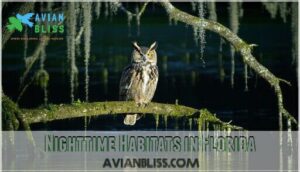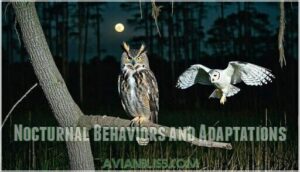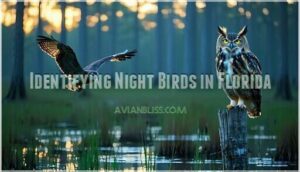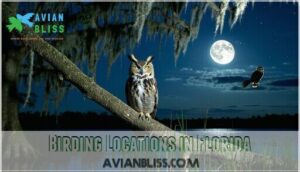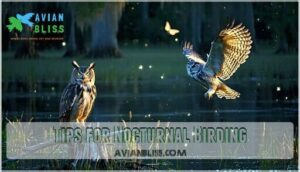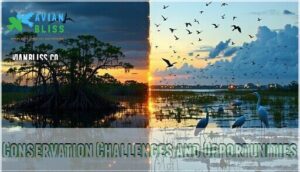This site is supported by our readers. We may earn a commission, at no cost to you, if you purchase through links.
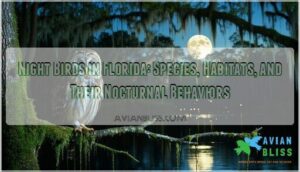 Florida’s night birds are an enchanting mix of stealth and grace.
Florida’s night birds are an enchanting mix of stealth and grace.
You’ve got owls like the Great Horned Owl and Barred Owl silently hunting in woodlands, while nightjars and nighthawks—think Common Nighthawk or Chuck-will’s-widow—sweep across open fields, snatching insects mid-flight.
In marshy areas, listen for the haunting calls of rails or the occasional squawk of a Least Bittern.
Even herons, like the Black-crowned Night-Heron, stalk prey in the moonlight.
These birds rely on sharp night vision, silent flight, and unique calls to thrive in the dark.
Curious about their secret lives? There’s more to uncover about Florida’s nocturnal wonders.
Table Of Contents
- Key Takeaways
- Nocturnal Birds of Florida
- Nighttime Habitats in Florida
- Nocturnal Behaviors and Adaptations
- Identifying Night Birds in Florida
- Birding Locations in Florida
- Tips for Nocturnal Birding
- Conservation Challenges and Opportunities
- Frequently Asked Questions (FAQs)
- What is the noisy night bird in Florida?
- What kind of bird makes noise at night?
- What kind of birds fly at night in Florida?
- What kind of bird sings all night in Florida?
- What birds come out at night in Florida?
- What kind of birds make noise at night?
- Why do birds chirp at night in Florida?
- What birds are active at night in Florida?
- What is a bird that is active at night?
- What birds fly late at night?
- Conclusion
Key Takeaways
- You’ll find Florida’s night birds, like owls, nightjars, and herons, thriving in diverse habitats such as woodlands, marshes, and open fields, each perfectly suited to their nocturnal adaptations.
- Owls, including Barred and Great Horned Owls, use sharp night vision and silent wings to hunt, while nightjars and nighthawks excel at catching insects in flight with precision.
- Patience and the right tools, like red-light flashlights and binoculars, help you spot eye shine and hear unique calls, such as Barred Owls’ “Who cooks for you?” or the rasp of a Chuck-will’s-widow.
- Conservation challenges, like habitat loss and climate change, threaten nocturnal birds, but citizen science and habitat restoration offer ways to protect their future.
Nocturnal Birds of Florida
Florida’s nights come alive with an array of fascinating birds perfectly adapted to the dark.
From stealthy owls to swift nighthawks, each species offers unique behaviors and traits that make exploring their world an exciting challenge.
Owls: The Nighttime Hunters
Owls are expert nighttime hunters and a fascinating part of Florida’s nocturnal birdlife.
Masters of the night, owls hunt with silent wings, razor-sharp talons, and unmatched precision under Florida’s starry skies.
These skilled predators thrive in diverse Owl Habitats, using silent wings, sharp talons, and unmatched hearing to track prey. Owl Diets vary but often include rodents and insects.
- Barn Owls: Glide silently, sweeping fields for small mammals.
- Great Horned Owls: Florida birds known for iconic hoots.
- Barred Owls: Famous for "Who cooks for you?" Owl Calls.
- Eastern Screech-Owls: Masters of suburban camouflage.
Nighthawks and Nightjars: The Silent Fliers
Nighthawks and nightjars in Florida are marvels of the crepuscular hours.
They excel at Camouflage Techniques by blending with trees and rooftops.
Their Insectivore Diet powers acrobatic flights, aided by unique Wing Morphology for silent hunting.
Listen for the Chuck-will’s-widow‘s haunting calls during Breeding Displays.
The Common Nighthawk’s dusk flights highlight their grace, making nocturnal birding unforgettable!
Rails and Bitterns: Birds of The Marshes
In Florida’s marsh habitats, rails and bitterns stay hidden like nature’s best-kept secrets.
Their calls echo softly, revealing their nocturnal presence.
- Clapper Rails scurry through the Everglades’ grasses.
- American Bitterns master camouflage among reeds.
- Sora Rails forage delicately at dusk.
- Virginia Rails, shy yet charming, glide silently.
- Least Bitterns perch amidst stalks, blending perfectly.
Protecting wetlands guarantees these elusive birds thrive, enriching wetland ecology.
Herons and Egrets: Tall Nighttime Stalkers
Herons and egrets are the graceful stalkers of Florida’s wetlands, slipping through the shadows like ghostly sentinels. These wading birds rely on sharp eyesight and specialized hunting techniques to thrive at night. Watching them feels like nature’s poetry in motion.
Looking for them? Here’s how to spot these heron species:
- Silhouettes: You’ll often see tall figures standing motionless in calm waters, like statues waiting for dinner.
- Beak Movements: Their quick, stabbing beaks expertly snag fish under moonlit reflections.
- Nighttime Hunters: The Black-crowned Night Heron wears sleek black-and-gray feathers, while the Yellow-crowned Night Heron flaunts a golden “crown.”
- Egret Adaptations: Their long legs, built for wading, give stability, even in squishy marshes. Egrets, belonging to Genus Egretta, are often smaller than herons.
Sadly, habitat loss threatens these majestic beings.
Nighttime Habitats in Florida
You’ll find Florida’s night birds in habitats as diverse as swamps, woodlands, and marshes, each offering unique shelter and food sources.
These environments support their nocturnal lifestyles, from hunting insects in wetlands to nesting in quiet trees or open fields, which is crucial for their survival in diverse habitats.
Woodlands and Swamps
Woodlands and swamps in Florida come alive at night, becoming a symphony of Swamp Birdsong and forest whispers.
Among the tree canopies, Eastern Screech-Owls blend seamlessly, showcasing incredible Camouflage Techniques. On the forest floor, the Great Horned Owl rules as a powerful predator, its haunting hoots echoing through the dark.
Swamps, with their dense Wetland Conservation areas, host Barred Owls whose “Who cooks for you?” call adds charm to the night.
By the water’s edge, Black-crowned Night-Herons master Forest Foraging, silently hunting with unmatched patience. Understanding Nesting Habitats helps you spot these elusive nocturnal birds.
Whether it’s the owls in forests or nightjars in wetlands, these habitats reveal the magical life thriving once the sun sets.
Open Fields and Barns
Picture a quiet field at dusk, where Barn Owls glide silently like ghostly sentinels.
These night birds thrive in Florida’s open fields and serene rural barns, hunting rodents with laser-sharp precision.
Their Barn Owl habitats often include farm lofts or abandoned buildings, blending perfectly into rustic settings.
These owls aren’t just stunning; they play a pivotal role in rodent control.
Open fields also contribute to agricultural production and livestock.
Spotting one requires patience, as they’re masters of stealth.
Avoid artificial lighting to observe their elegant flights in unspoiled darkness!
Saltwater Marshes
Saltwater marshes hum with life, especially after sunset.
These habitats play a key role in the marsh food web, attracting nocturnal birds that rely on rich biodiversity and unique conditions shaped by salinity effects and tides.
Listen for these nocturnal vocals:
- Clapper Rails, whose rhythmic "claps" punctuate the quiet.
- The elusive Black Rail, whispering its high-pitched "ki-ki-krr."
- Least Bitterns, experts at hiding, cooing softly from vegetation.
Coastal development threatens these essential habitats, but habitat restoration can protect their role in bird migration and biodiversity.
Freshwater Wetlands
Freshwater wetlands in Florida are teeming with life and attract a fascinating variety of nocturnal birds.
These lush ecosystems, brimming with insects, amphibians, and small fish, offer the perfect buffet for creatures like the elusive Black Rail, whose "ki-ki-krr" calls echo through the night. Keep an eye out for the striking Yellow-crowned Night-Heron, often spotted stalking shallow waters with impressive precision.
Wetland bird diets depend heavily on the abundance of prey found in these habitats, but threats like habitat loss and invasive species are altering this delicate balance.
Beyond supporting Everglades birds and other night birds, these wetlands filter water, improving water quality.
Supporting conservation strategies for wetlands guarantees their survival—for both wildlife and water systems alike.
Nocturnal Behaviors and Adaptations
You’ll notice Florida’s night birds have evolved remarkable adaptations that let them thrive in darkness, from the Great Horned Owl‘s sensitive eyes that gather available light to the Chuck-will’s-widow’s specialized feathers that enable silent flight.
These nocturnal specialists also possess unique foraging strategies, with Barred Owls using their acute hearing to locate prey beneath leaf litter and Black-crowned Night Herons standing motionless in shallow water for hours to catch unsuspecting fish.
Unique Visual and Acoustic Adaptations
Moving from Florida’s diverse nighttime habitats, let’s examine how these birds have specially adapted to thrive after dark.
Florida’s nocturnal birds possess remarkable visual and acoustic adaptations.
With enhanced nocturnal vision, their eyes contain abundant rod cells that capture minimal light.
Specialized hearing allows owls to pinpoint prey through asymmetrical ear placement, while nightjars detect the faintest insect movements.
Owls also possess unique zygodactyl feet with two toes facing forward and two facing backward.
Their survival toolkit includes:
- Camouflage plumage that blends perfectly with bark and foliage
- Complex call systems ranging from the Chuck-will’s-widow’s namesake song to the Barred Owl’s distinctive hooting
- Specialized wing feathers that enable silent flight, particularly in owls hunting unsuspecting prey
Nocturnal Foraging Habits
As you explore Florida’s nightlife, you’ll discover nocturnal birds like owls, nighthawks, and nightjars with unique foraging habits.
They forage at dusk and dawn, feeding on insects in flight.
Some key adaptations include:
- Insect consumption using wide, gaping mouths
- Rodent predation and fish hunting with sharp eyesight
- Diet adaptations influenced by lunar cycles
The Common Nighthawk, for example, can be identified by its angled, pointed wings during flight, showcasing its unique characteristics.
Silent Flight Patterns
Gliding through the night, nocturnal birds like owls, nighthawks, and nightjars in Florida have a unique talent: silent flight. This ability isn’t just impressive—it’s a product of ingenious evolution designed for stealthy hunting.
Their feather adaptations play a huge role. Soft, fringed edges on their primary feathers dampen sound, silencing the turbulence that flapping wings typically create.
You’ll also notice their wing morphology. Birds like the Great Horned Owl use large, broad wings for slow, precise movements, while nighthawks rely on long, slender wings for gliding effortlessly across the sky.
These hunting styles make them virtually undetectable, offering massive evolutionary advantages. Prey detection becomes easier when their swoops go unheard, giving night birds in Florida a clear edge in catching their next meal.
Nature’s engineering guarantees each flight merges efficiency and surprise, making these nighttime fliers masters of the silent hunt.
Eye Shine and Bioluminescence
Florida’s night birds dazzle with their glowing eyes, a product of clever nocturnal adaptation.
While owls and other night birds lack a tapetum lucidum, their retinal pigments reflect light spectacularly, enhancing vision in the dark. Bioluminescent prey, like dinoflagellates or comb jellies, adds to nighttime magic.
Here’s how to enjoy the glow:
- Spot eye reflections—look for those eerie, shimmering glints.
- Tune into calls—night birds like owls serenade the dark.
- Notice moving shadows—small movements reveal hidden treasures.
Florida’s nightlife is a scene of light sensitivity and endless wonder. Don’t miss it!
Identifying Night Birds in Florida
You can identify night birds in Florida by listening for their unique calls and observing their distinctive features, like wing patterns or eye shine.
With some practice and the right tools, spotting these elusive birds becomes an exciting challenge.
Unique Vocal Signatures
Listening to nocturnal birds in Florida is like tuning into nature’s symphony.
Each species has its unique rhythm:
- Owl calls: Barred Owls hoot “who-cooks-for-you” while Great Horned Owls bellow low and deep.
- Nighthawk booms: Males produce dramatic "booming" displays.
- Whip-poor-will song: This haunting melody echoes steadily across woodlands.
- Heron croaks and Mockingbird mimicry: Herons grunt low “garks” and mockingbirds mix countless mimicked sounds.
Online tools and apps can preview these bird sounds, preparing you for nature’s nighttime concert.
Visual Identification Tips
Spotting nocturnal birds in Florida feels like solving a nature mystery.
Focus on plumage patterns—think the Great Horned Owl’s mottled grays or the Barn Owl’s pale hues. Use habitat clues to guide you; barns, woodlands, or fields all host unique species.
For silhouette recognition, watch the shape of wings and body against the moonlight. Keep an eye out for eye shine, too—bright yellow or reflective black are telltale signs.
Here’s a quick reference:
| Feature | Example Bird | Unique Trait |
|---|---|---|
| Plumage Patterns | Great Horned Owl | Mottled gray-brown |
| Eye Shine | Barred Owl | Reflective black eyes |
| Silhouette Recognition | Nighthawk | Angular wings |
| Habitat Clues | Barn Owl | Roosts in open areas |
Stay curious—it’s fascinating!
Online Identification Tools
In the context of spotting and identifying nocturnal birds in Florida, online tools are a game-changer.
They’re perfect for unraveling the mystery behind those strange bird sounds or spotting owls in the wild.
Try these helpful options:
- Merlin Bird ID: Upload your bird photos or describe what you saw for spot-on results with impressive app accuracy.
- Xeno-canto: Match bird sounds like a pro with its massive database of nocturnal calls.
- Expert Forums: Connect with birders worldwide and share sightings or sound clips for feedback.
Consider exploring the Merlin Bird ID products for enhanced birding experiences.
Using apps with regional filters or photo submissions makes bird identification easier and more exciting, even for early-morning “who cooks for you?” calls!
Field Guides and Apps
When you’re out spotting Florida’s nocturnal birds, a trusty field guide or app can make all the difference.
Field guides are fantastic for offline access with detailed visuals, range maps, and descriptions, helping you recognize species like owls by their plumage or habitat. However, guide limitations include the lack of interactive features or live updates.
That’s where birding apps step in. Apps bring you digital updates, app accuracy, and even community features. Use audio recognition to pinpoint bird sounds (like the Barred Owl’s famous “Who cooks for you?”).
Many apps let you upload photos for ID or access real-time maps. Some even work without service for those deep-woods adventures. Consider supplementing your toolkit with specialized guides available for nocturnal species.
With the right tools, your bird identification game will soar like the birds themselves.
Birding Locations in Florida
You’ll find Florida’s night birds in some of the state’s most iconic locations, each offering unique habitats teeming with nocturnal activity.
From the sprawling Everglades to local parks and refuges like Merritt Island, these spots provide prime opportunities for observing owls, nightjars, and other nocturnal species.
Everglades National Park
Everglades National Park is a treasure trove of nocturnal birds in Florida.
Everglades National Park offers a magical glimpse into Florida’s nocturnal birdlife, where owls and herons thrive in moonlit wetlands.
Explore diverse habitats like marshes and cypress swamps to spot owls, such as Eastern Screech-Owls and Barred Owls, or marvel at herons like the Black-crowned Night-Heron.
Carry a red-light flashlight—wildlife will thank you!
Trails like Mahogany Hammock offer prime chances to witness the beauty of Nighthawk habitats while supporting wetland conservation in this awe-inspiring Park Birdlife sanctuary.
Merritt Island National Wildlife Refuge
At Merritt Island National Wildlife Refuge, located along Florida’s vibrant Space Coast, you’ll uncover one of the top spots to experience nocturnal birds in their element.
Stretching across 140,000 acres, this refuge isn’t just rich in beauty—it’s a haven for bird habitats and Refuge Bird Species.
Its Lagoon Ecosystem and diverse landscapes, from wetlands to coastal dunes, create prime conditions for owls, night birds, and other wildlife.
As dusk settles, keep an ear out for haunting calls that bring the refuge alive.
Be sure to check the visitor center for tips or updates, as NASA’s nearby activity can impact access.
This blend of Habitat Restoration and Conservation Efforts makes Merritt Island truly unforgettable for Florida birdwatchers, offering a unique experience of nocturnal birds in their natural element with a focus on Refuge Bird Species.
Cape May County Park
Cape May County Park immerses you in Florida’s vibrant nocturnal birdlife.
Stroll the birding trails under a starry sky, where habitat diversity supports owls, nightjars, and other night birds.
Rangers often share tips during seasonal migrations, helping you spot elusive species.
Listen closely for unique calls—each one tells a story of nature’s conservation efforts in action, and supports the nocturnal birdlife.
Local Birding Hotspots
Florida’s birding treasures extend beyond famous spots, offering hidden wonders for night bird enthusiasts. Smaller, local hotspots are perfect for Urban Birding, snapping photos, or soaking in nocturnal sounds.
Some of the best experiences unfold in Coastal Hotspots or Inland Sanctuaries, teeming with unique birds after dark. State parks and private lands also host thriving habitats.
- Explore State Parks for owls and nightjars.
- Seek Urban Birding trails for surprise sightings.
- Join coastal expeditions for rare bird activities.
- Collaborate with local experts to plot nocturnal visits.
Your next birding adventure might just be around the corner!
Tips for Nocturnal Birding
When you’re searching for night birds in Florida, patience and preparation are key to spotting these elusive creatures.
By moving quietly, using the right tools, and tuning into the sounds of the night, you’ll increase your chances of a successful and rewarding experience.
Move Slowly and Speak Softly
Quietly exploring the realm of nocturnal birds in Florida means perfecting the art of Respectful Observation.
Silence and smooth movements help minimize disturbance to owls, nighthawks, and nightjars. Essential birding gear can greatly improve your chances of spotting these elusive creatures.
Follow these steps for bird wellbeing:
- Walk gently: Imagine sneaking past a sleeping baby—slow, deliberate steps avoid noise pollution.
- Keep whispers soft: Stick to hushed tones that won’t disrupt the night.
- Dress dark: Blend in with non-reflective clothing.
- Pause often: Ethical considerations matter; let the birds feel safe in their habitat.
Listen Carefully and Look for Eye Shine
Listening is your greatest tool when searching for nocturnal birds in Florida. Many species, like owls, nighthawks, and nightjars, announce their presence through unique sounds. Learn their bird call variations to recognize species like the Eastern Whip-poor-will with its rhythmic "whip-poor-will" or the Black Rail’s sharp “ki-ki-krr.”
Acoustic identification connects you to these hidden voices. Pair your ears with your eyes. A flashlight can reveal eye shine colors, from golden glints to eerie reds, reflecting a bird’s direction like nature’s own spotlight.
Here’s a quick reference guide:
| Bird | Call | Eye Shine Colors |
|---|---|---|
| Eastern Whip-poor-will | "Whip-poor-will" | Reddish-gold |
| Black Rail | "Ki-ki-krr" | Pale yellow |
| Barred Owl |
"**Who cooks for you?
"
peent**"
Stay quiet and patient—magic unfolds every night in Florida’s habitats, where nocturnal birds can be found, and their unique sounds and eye shine colors can be observed, making for a truly enchanting experience with nature’s own spotlight.
Use Red Light and Binoculars
Spotting nocturnal birds in Florida, like owls or nightjars, requires the right tools and techniques.
A red light is perfect for maintaining your night vision while highlighting eye shine without scaring the birds—an invaluable benefit during night bird watching.
Pair it with binoculars designed for low-light magnification to catch incredible details, like the heart-shaped face of a Barn Owl.
Adjust your eyes to the dark before getting started for maximum visibility. Choosing high-quality, ethical equipment guarantees you enhance the experience without disturbing wildlife.
Using specific equipment is key to successful red light birding. With patience and the right gear, you’ll witness Florida’s nighttime birds like never before—an unforgettable adventure!
Be Patient and Enjoy The Experience
Patience is your best tool for spotting nocturnal birds. Slow down, embrace the stillness, and sharpen your senses. With mindful observation and relaxed focus, you’ll notice subtle calls or eye shine that reveal their presence.
- Practice sensory awareness: Tune into distant sounds and faint movements.
- Immerse yourself in nature: Let Florida’s night envelop you.
- Reflect quietly: Observe bird behavior respectfully for unforgettable bird sightings.
Enjoy the magic of nighttime bird watching!
Conservation Challenges and Opportunities
You’ll face serious challenges regarding protecting Florida’s night birds, from habitat loss to the effects of climate change.
At the same time, conservation offers opportunities like citizen science programs and habitat restoration to make a real difference.
Habitat Fragmentation and Destruction
Florida’s rapid urbanization is taking a toll on night birds.
Habitat destruction and shrinking habitats lead to challenges like prey scarcity and nesting disruption.
Here’s how it plays out:
- Urban sprawl fragments habitats, leaving birds like barn owls stranded in smaller, isolated areas.
- Road mortality from traffic cuts through wildlife corridors, disrupting traditional flight paths and hunting grounds.
- Light pollution confuses nocturnal birds, making it harder to forage.
Protecting Florida’s natural spaces is essential to ensuring these nocturnal creatures thrive.
Climate Change and Its Impact
Climate change throws a wrench into Florida’s delicate ecosystems, particularly for night birds.
Rising temperatures disturb breeding cycles, while habitat loss forces birds to adjust feeding habits.
Coastal nesting spaces vanish due to sea level rise and extreme weather events—leaving species scrambling for safety.
Shifting ranges and dwindling prey availability disrupt migration timing, making survival tougher.
Night birds face increased risks, but conservation efforts can help reverse these changes.
Protecting their habitats isn’t just essential—it’s an urgent race against time to ensure the survival of these species.
Citizen Science and Conservation Initiatives
You don’t need fancy gear or years of experience to help with bird conservation in Florida.
Simple actions like participating in citizen science projects make you part of something bigger. Programs like the Nightjar Survey Network allow you to record bird calls from your porch, contributing to essential data collection.
Try NestWatch, where monitoring nest boxes teaches you about breeding behaviors while supporting habitat monitoring.
Public awareness campaigns, like “Lights Out,” encourage bird-friendly practices that reduce light pollution.
Plus, there are funding opportunities for local nest box programs. Your observations aren’t just fun—they’re pivotal to bird conservation efforts and creating effective, long-lasting solutions.
Protecting Nocturnal Bird Habitats
Let’s talk about how you can help protect Florida’s nocturnal bird habitats and keep their nighttime songs alive.
Night birds like owls and nighthawks rely on a healthy environment to thrive, but human activity can disrupt their routines.
Fortunately, there are simple yet impactful ways you can make a difference:
- Habitat Restoration: Participate in projects that rebuild green spaces for wildlife.
- Light Pollution: Swap outdoor fixtures for shielded, motion-sensor lights to protect their natural hunting patterns.
- Invasive Species: Remove non-native plants that crowd out the food sources birds depend on.
- Pesticide Reduction: Use natural pest control methods to keep insects available for bird diets.
- Community Engagement: Join local conservation groups to amplify efforts.
- Bird Conservation Advocacy: Support policies that preserve parks and critical habitats.
Simple actions today mean safer skies tomorrow.
Frequently Asked Questions (FAQs)
What is the noisy night bird in Florida?
Ever heard a bird that sounds like it’s practicing its stand-up routine at 3 AM?
The mocking laughter belongs to the Northern Mockingbird, Florida’s nocturnal noisemaker, singing endless melodies under the moonlight.
What kind of bird makes noise at night?
Birds like the Eastern Whip-poor-will, Barred Owl, and Northern Mockingbird often make noise at night.
Their calls range from melodic songs to eerie hoots, creating a nighttime symphony that’s both fascinating and mysterious.
What kind of birds fly at night in Florida?
Ever wonder who’s soaring through Florida’s night skies?
Birds like Common Nighthawks, Eastern Whip-poor-wills, and Barn Owls dominate.
With sharp night vision, they hunt insects or small prey under moonlit skies.
What kind of bird sings all night in Florida?
The Northern Mockingbird sings all night in Florida, especially during breeding season or full moons.
Its melodic songs, full of imitations and whistles, remind you that nature’s concert doesn’t stop when the sun goes down.
What birds come out at night in Florida?
When the sun goes down in Florida, you’ll hear Barred Owls hooting, Chuck-will’s-widows calling, and Northern Mockingbirds singing.
Nightjars like Common Nighthawks also take flight, hunting insects with incredible precision under twilight skies.
What kind of birds make noise at night?
Like a night symphony, birds such as Chuck-will’s-widows, Eastern Whip-poor-wills, and Barred Owls fill the dark with calls.
Ranging from haunting hoots to repetitive whistles, each serving a purpose from courtship to territory defense, with the calls being an essential part of their behavior, is a key aspect of their courtship.
Why do birds chirp at night in Florida?
Sometimes it’s the search for mates, a bustling nightlife routine, or even bright city lights confusing their schedules.
Florida’s chirping night birds serenade the dark, blending nature’s rhythms with their survival instincts.
It’s enchanting!
What birds are active at night in Florida?
When the night owls come out, Florida’s skies host creatures like the Barred Owl, Chuck-will’s-widow, and Eastern Whip-poor-will.
These nocturnal acrobats hunt insects, sing haunting tunes, and thrive under moonlit skies.
What is a bird that is active at night?
A great example is the Barn Owl.
With its ghostly white face and silent flight, it hunts rodents under moonlight.
Its eerie, raspy screech might startle you, but it’s all part of nature’s charm.
What birds fly late at night?
You might think most birds sleep at night, but several species, like the Barn Owl and Common Nighthawk, thrive after dark.
They silently search for prey, using keen senses and stealthy flight to hunt.
Conclusion
Night birds in Florida are both elusive and abundant, blending mystery with beauty under the cover of darkness.
From the haunting calls of owls to the silent glides of nightjars, these birds showcase adaptations like sharp night vision and quiet flight.
Exploring their habitats—woodlands, marshes, and open fields—reveals their secret world.
Grab binoculars, tread lightly, and listen closely for their unique songs, to uncover the magic of Florida’s nocturnal birdlife, which offers unrivaled wonders for those patient enough to uncover it.
- https://upload.wikimedia.org/wikipedia/commons/4/4b/Chordeiles_minor.ogg
- https://sora.unm.edu/sites/default/files/3.%20JENNIER%2C%20NIGHTHAWKS%2C%20FFN%2043%281%29.pdf
- https://www.audubon.org/field-guide/bird/black-crowned-night-heron
- https://egwzwrd7oo7.exactdn.com/wp-content/uploads/2023/12/XC664292-Northern-Mockingbird-Mimus-polyglottos.mp3
- https://en.wikipedia.org/wiki/Hunting

